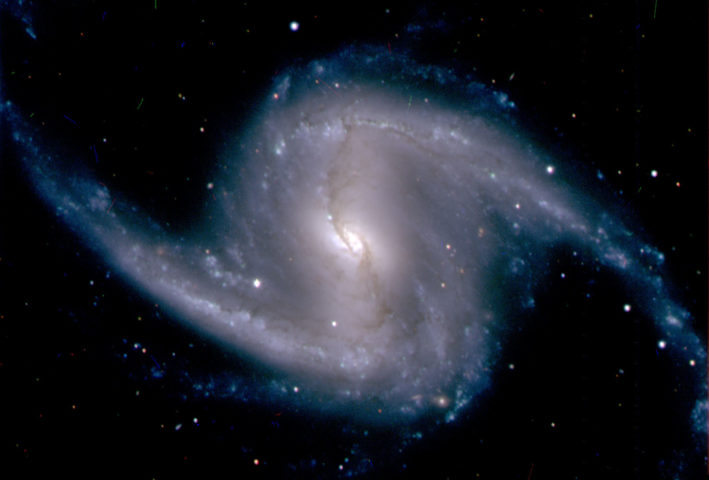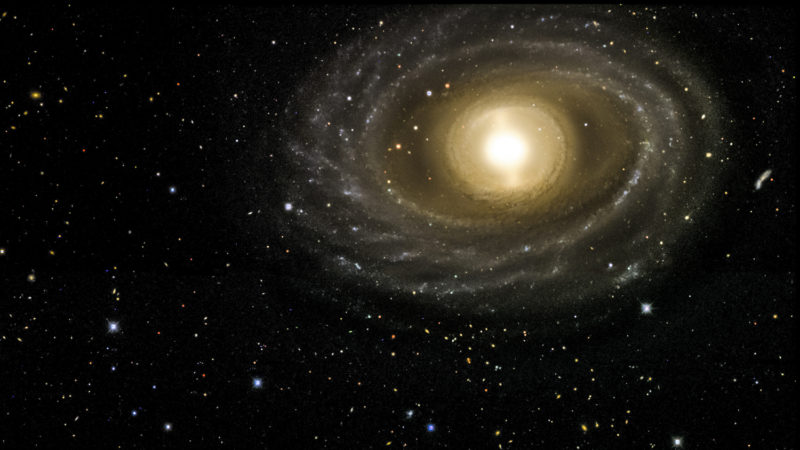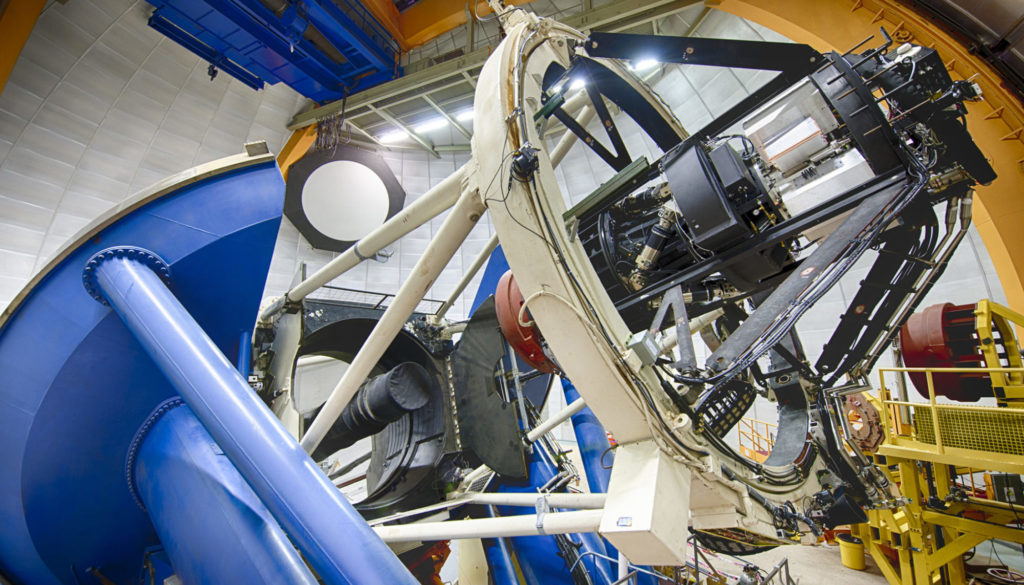Dark Energy Survey Begins Five-Year Mission to Map Southern Sky
On an otherwise unremarkable evening last Saturday (Aug. 31) in Chile, the first official image in the Dark Energy Survey (DES) was recorded by the world’s most powerful digital camera, marking the beginning of a new era of discoveries about dark energy and other mysteries of the universe.
For hundreds of nights — Saturdays and otherwise — during the next five years, an international team of physicists and astronomers featuring scientists from Texas A&M University will use this remarkable machine, for which Texas A&M astronomer Darren DePoy served as the project scientist, to try to answer some of the most fundamental questions about the cosmos.


Harnessing the extraordinary power of the Dark Energy Camera, a 570-megapixel digital device built at Fermilab and mounted on the 4-meter Victor M. Blanco Telescope at the National Science Foundation’s Cerro Tololo Inter-American Observatory in Chile’s Andes Mountains, scientists will systematically map one-eighth of the sky (5,000 square degrees) in unprecedented detail. As the main tool of the survey, the camera features 5 precisely shaped lenses, the largest nearly a yard across, that together provide sharp images over its entire field of view.
[To see the Dark Energy Camera’s resolution capabilities, check out DECam Interactive.]
“With the start of the survey, the work of more than 200 collaborators is coming to fruition,” said DES Director Josh Frieman of the U.S. Department of Energy’s Fermi National Accelerator Laboratory. “It’s an exciting time in cosmology, when we can use observations of the distant universe to tell us about the fundamental nature of matter, energy, space, and time.”
Saturday’s start marked the culmination of 10 years of planning, building and testing by scientists from 25 institutions in six countries. The survey’s goal is to find out why the expansion of the universe is speeding up, instead of slowing down due to gravity, and to probe the mystery of dark energy, the force believed to be causing that acceleration.
“The start of the survey is a great thing to see after almost a decade of work on the instrument, telescope, software and plans,” said DePoy, a member of Texas A&M’s George P. and Cynthia Woods Mitchell Institute for Fundamental Physics and Astronomy and holder of the Rachal-Mitchell-Heep Endowed Professorship in the Department of Physics and Astronomy. “Texas A&M is an institutional member of DES and will have full access to the data as it rolls in — a fact that already is having a positive impact on Ph.D. dissertation research and our reputation as an excellent program. Of course, the parts of the instrumentation that Texas A&M designed and built are working flawlessly — a tribute to our lab and the students and staff who do the work.”
The Dark Energy Camera, known as DECam and revered as the most powerful survey instrument of its kind, is able to see light from more than 100,000 galaxies up to 8 billion light years away in each snapshot. A key sub-component of the camera — a spectrophotometric calibration system known as DECal that will allow the camera to obtain very high precision brightness measurements of the objects it sees in the sky — was built within Texas A&M’s Charles R. ’62 and Judith G. Munnerlyn Astronomical Laboratory under the direction of DePoy and senior research scientist Jennifer L. Marshall.
“We expect DECam will have a long and productive life on the telescope,” DePoy said. “The combination represents a new capability available to the entire astronomical community, one that can produce unprecedented science. We’re excited that Texas A&M Astronomy is part of such a groundbreaking project.”
CTIO Director Nicole van der Bliek described Saturday’s start-up as an important milestone. “The Dark Energy Camera, in conjunction with the Blanco telescope here at CTIO, will greatly increase our understanding of the forces that control the expansion of our universe,” she added.
During the next five years, the survey will obtain color images of 300 million galaxies and 100,000 galaxy clusters and will discover 4,000 new supernovae, many of which were formed when the universe was half its current size. The data collected will be processed at the National Center for Supercomputing Applications (NCSA) at the University of Illinois in Urbana, and then delivered to collaboration scientists and the public.
“The Dark Energy Survey will be one of the most important surveys in the next 10 years, not just because of the targeted science, but because so many astronomers will be able to take their own data and do their research,” said Nicholas B. Suntzeff, university distinguished professor of physics and astronomy at Texas A&M and director of the university’s astronomy program. “This is the most carefully designed project I have ever been involved in, and the science from the Dark Energy Survey will be spectacular.”
Suntzeff, who holds the Mitchell-Heep-Munnerlyn Chair in Observational Astronomy within Texas A&M’s Mitchell Institute and helped to discover dark energy using the Blanco telescope, sees positive progress in Chile for the overall astronomy profession well beyond the DES project, which he says offers tangible testimony to the power of public observatories and related worldwide collaboration in science.
“So many people from so many places collaborated to bring this instrument to the Blanco telescope,” Suntzeff said. “At a time when ground-based optical and infrared astronomy is retreating from publicly available telescopes to facilities available to only a few institutions, the design and funding of this telescope continues to goes in the other direction. It is an instrument available to all users, and more time will be granted to general users than has been given to the project itself.”
The survey will use four methods to probe dark energy — counting galaxy clusters, measuring supernovae, studying the bending of light and using sound waves to create a large-scale map of expansion over time — combining these for the first time ever in a single experiment. While the survey’s observations will not be able to see dark energy directly, project officials believe that by studying the expansion of the universe and the growth of large-scale structure over time, the survey will give scientists the most precise measurements to date of the properties of dark energy.
The Dark Energy Survey is supported by funding from the U.S. Department of Energy Office of Science; the National Science Foundation; funding agencies in the United Kingdom, Spain, Brazil, Germany and Switzerland; and the participating institutions.
More information about the Dark Energy Survey, including the list of participating institutions, is available at the project website at www.darkenergysurvey.org.
Additional information and quotes about the project can be found in the official press release, which features additional photographs and illustrations.
For more information about the instrument and telescope, go to Cerro Tololo Inter-American Observatory.
To learn more about Texas A&M Astronomy, the Dark Energy Camera, the Large Synoptic Survey Telescope and other major international projects involving Texas A&M astronomers, visit Astronomy Research Page.
# # # # # # # # # #
About Research at Texas A&M University: As one of the world’s leading research institutions, Texas A&M is in the vanguard in making significant contributions to the storehouse of knowledge, including that of science and technology. Research conducted at Texas A&M represents annual expenditures of more than $776 million. That research creates new knowledge that provides basic, fundamental and applied contributions resulting in many cases in economic benefits to the state, nation and world. To learn more, visit http://vpr.tamu.edu.
About Fermilab: Fermilab, America’s premier national laboratory for particle physics research, is a Department of Energy national laboratory operated under contract by the Fermi Research Alliance, LLC. The DOE Office of Science is the single largest supporter of basic research in the physical sciences in United States.
News release courtesy of Fermilab, the National Optical Astronomy Observatory (NOAO) and the National Center for Supercomputing Applications on behalf of the Dark Energy Survey collaboration. NOAO is operated by the Association of Universities for Research in Astronomy (AURA), Inc. under cooperative agreement with the National Science Foundation.
Watch an overview of the Dark Energy Survey project featuring the scientists who are involved, courtesy of Fermilab on You Tube:
-aTm-
Texas A&M Contacts: Shana K. Hutchins, (979) 862-1237 or shutchins@science.tamu.edu or Dr. Darren DePoy, (979) 862-2082 or depoy@physics.tamu.edu
DES Media Contact: Andre Salles, Fermilab Office of Communication, (630) 840-3351 or media@fnal.gov
The post Dark Energy Survey Begins Five-Year Mission to Map Southern Sky appeared first on Texas A&M College of Science.
